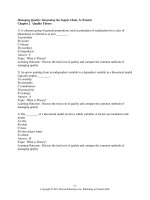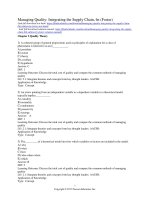Lecture Operations management: Creating value along the supply chain (Canadian edition) - Chapter 14
Bạn đang xem bản rút gọn của tài liệu. Xem và tải ngay bản đầy đủ của tài liệu tại đây (3.22 MB, 44 trang )
OPERATIONS MANAGEMENT:
Creating Value Along the Supply Chain,
Canadian Edition
Robert S. Russell, Bernard W. Taylor III, Ignacio Castillo, Navneet Vidyarthi
§
CHAPTER 14
Sales and Capacity Planning
1
§
Learning Objectives
The Sales and Operations Planning Process
Strategies for Adjusting Capacity
Strategies for Managing Demand
Quantitative Techniques for Aggregate Planning
Hierarchical Nature of Planning
Aggregate Planning for Services
14-2
§
Sales and Operations Planning
Determines resource capacity to meet
demand over an intermediate time horizon
Aggregate refers to sales and operations
planning for product lines or families
Sales and Operations planning (S&OP) matches
supply and demand
Objectives
Establish a company wide plan for allocating
resources
Develop an economic strategy for meeting
demand
14-3
§
Sales and Operations Planning Process
14-4
§
Monthly S&OP Planning Process
14-5
§
Disaggregation
Breaking an aggregate plan into more detailed
plans
Create Master Production Schedule for Material
Requirements Planning
14-6
§
Collaborative Planning
Sharing information and synchronizing production
across supply chain
Part of CPFR (collaborative planning, forecasting,
and replenishment)
involves selecting products to be jointly managed,
creating a single forecast of customer demand, and
synchronizing production across supply chain
14-7
§
Available-to-Promise (ATP)
Quantity of items that can be promised to
customer
Difference between planned production and
customer orders already received
Capable-to-promise
quantity of items that can be produced and mad available
at a later date
14-8
§
ATP
14-9
§
ATP
14-10
§
ATP
14-11
§
Rule Based ATP
14-12
§
Meeting Demand Strategies
Adjusting capacity
Resources to meet demand are acquired and maintained
over the time horizon of the plan
Minor variations in demand are handled with overtime or
under-time
Managing demand
Proactive demand management
14-13
§
Strategies for Adjusting Capacity
Level production
Producing at a constant rate and using inventory to
absorb fluctuations in demand
Chase demand
Hiring and firing workers to match demand
Peak demand
Maintaining resources for high-demand levels
14-14
§
Strategies for Adjusting Capacity
Overtime and under-time
Increase or decrease working hours
Subcontracting
Let outside companies complete the work
Part-time workers
Hire part-time workers to complete the work
Backordering
Provide the service or product at a later time period
14-15
§
Level Production
Units
Demand
Production
Time
14-16
§
Chase Demand
Demand
Units
Production
Time
14-17
§
Strategies for Managing Demand
Shifting demand into other time periods
Incentives
Sales promotions
Advertising campaigns
Offering products or services with counter-cyclical
demand patterns
Partnering with suppliers to reduce information
distortion along the supply chain
14-18
§
Quantitative Techniques For AP
Pure Strategies
Mixed Strategies
Linear Programming
Transportation Method
Other Quantitative Techniques
14-19
§
Pure Strategies
14-20
§
Level Production Strategy
Level production
(50,000 + 120,000 + 150,000 + 80,000)
= 100,000 pounds
4
QUARTER
Spring
Summer
Fall
Winter
SALES
FORECAST
80,000
50,000
120,000
150,000
PRODUCTION
PLAN
INVENTORY
100,000
100,000
100,000
100,000
400,000
20,000
70,000
50,000
0
140,000
Cost of Level Production Strategy
(400,000 X $2.00) + (140,00 X $.50) = $870,000
14-21
§
Chase Demand Strategy
14-22
§
Level Production with Excel
14-23
§
Chase Demand with Excel
14-24
§
Mixed Strategy
Combination of Level Production and Chase
Demand strategies
Example policies
no more than x% of workforce can be laid off in one
quarter
inventory levels cannot exceed x dollars
Some industries may shut down manufacturing
during the low demand season and schedule
employee vacations during that time
14-25
§









